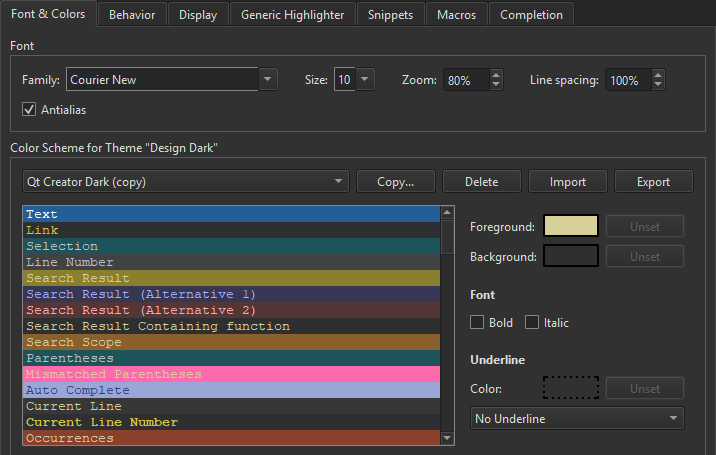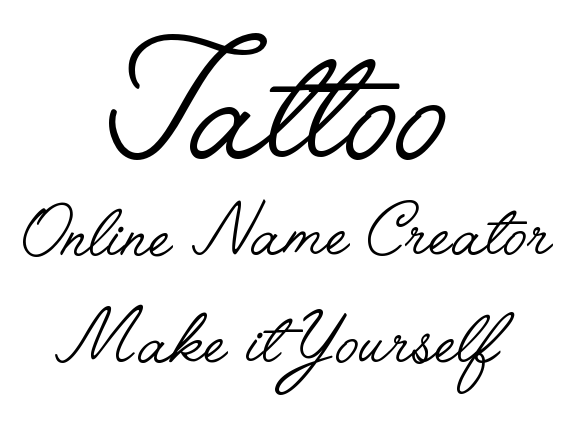Hi there! Ever wondered how people make text bold on their social media posts/bios when there aren't any formatting buttons? Well, this little web app allows you to convert normal text into bold text that you can copy and paste into your social media posts/bio/etc. The characters that are generated aren't actually a bold 'font', but rather a set of bold Unicode characters. That's why it's possible to copy and paste them (something that you can't do with normal 'fonts'). Think of these bold characters as separate 'glyphs', just like 'A' is different to 'a', and '%' is different to '$'. They're actually different characters/symbols - not just different 'styles' or 'fonts'.
FontForge is a free and open source font editor brought to you by a community of fellow type lovers. You can donate to support the project financially. FontCreator is an inspiring and beautifully designed font editor built to help you create amazing new fonts and edit existing fonts. Fontself Maker is an extension for Illustrator and Photoshop CC to quickly turn any lettering into OpenType fonts. Fonts generator Use fancy fonts to copy and paste to your bio, posts, and comments on social media. Custom text will bring more engagement and improve your profile aesthetics. Over 80+ font styles are available – just type anything in the Latin alphabet below.
Interested in how all this text font conversion stuff works? Let's take a dive into the origins of Unicode - the International not-for-profit organisation that creates the rules for how computers should convert binary (zeros and ones) into textual characters (like the ones you're reading now).
Unicode
In the early days of computing, there was no agreed-upon way of representing and rendering text in computer programs. Typography was a well-established field, but it hadn't yet made its way past the type-writer and into the digital realm. As computer usage increased, and as the early internet emerged, this became a problem. See, if you're a programmer, and you wanted your program to interface (connect to, or talk to) another program, then you need some sort of shared language. At the lowest level, computers transmit voltages (low/high, zero/one). These need to be somehow converted into something meaningful. So one programmer might say '001' means 'A', '002' means 'B', and so on. And then you can transmit messages by sending zeros and ones. Easy! Except that every programmer had their own 'codex'. So there'd be another programmer who's program interpretted '000' as 'A', and '001' as 'B', etc. And so it was as if everyone in a conversation was speaking a different language.

The solution to all this was to create 'translators' between the different formats, just like you would do in a conversation between people of different languages. But as you might imagine, this becomes cumbersome. Why couldn't everyone just speak the same language? That would make everything a lot easier.
Well, in the early 1980s, a group of employees from a bunch of large tech companies came together to try to create the 'universal' code for converting binary (zeros and ones) into text characters (like the ones you're reading right now). They called it Unicode.
Okay, so what does this all have to do with bold text? Well, we're getting there... You see, Unicode had quite a task on its hands. There were dozens of specifications out there in the wild already (public and private), and each of them had a lot of users, and many of the specifications were mainly for use in languages other than English. So how was Unicode going to cater to everyone's needs? They couldn't just put up a list of binary->ASCII codes and call it a day. They had a lot of work to do, and they didn't want it to take decades to get everyone using Unicode. The result? Mash all of the specifications together into one giant monstrosity that catered to everyone's needs. Okay, well that might be a bit of hyperbole, but there is some truth to it. Unicode needed to 'please' everyone if it was going to get fast adoption, so the most practical route was to try to make as many of the big players happy as possible.
The eventual result of this is a metaphorical explosion of of the spec, which now encodes over 100,000 different characters, including those of almost every language, all the emojis, and, importantly, a few different 'altered' Latin alphabets - which includes a few bold ones!
But why include bold characters in the spec? Why not just let developers use HTML, CSS, and separate font files to style the text in their applications? Two reasons: (1) HTML and CSS didn't come about until the late 80s, and (2) It was a bunch of extra effort if you just wanted a simple way to format text in a simple messaging application/protocol (like email!). So in other words, Unicode was focussed on being friendly to the people that it needed adoption from.
So there we have it! I hope that little bit of trivia was interesting to you, and that it's now at least a little bit more clear why the this isn't so much a 'bold font generator' as a 'bold unicode text generator'. You can copy and paste the bold characters because they're actually bold characters rather than just styled 'normal' characters. You can't copy and paste a bold font, but you can of course copy textual characters (like those produced by this generator) as you please.
Now, on to the specifics!
Font Creator Instagram
Bold Text
There are a few different bold alphabets within the Unicode standard. Many of the 'styled' Latin alphabets originated from the needs of mathematicians, chemists, and other academics who needed a way to express their equations in a digital format. Here are the non-italic bold Unicode alphabets, along with their Unicode names:

Math sans bold:
Math bold:
Math bold Fraktur
Math double-struck
You'll notice that the Fraktur alphabet doesn't include numbers. Unfortunately that's just because mathematicians did not use this script for numeric stuff, and instead only required bold letters for their purposes.
Bold Italic
There are two bold italic alphabets in Unicode, both of which can be generated using this website. Here they are:
Math sans bold italic
Math bold italic:
You'll notice that there are no numeric symbols in these sets. Again, this is because these characters were used in symbolic contexts (e.g. to represent algebraic variables).
Unicode Bold Characters
Here's a nice compact list of all the characters in the Unicode 'mathematical alphanumeric symbols' block. I've included the non-bold versions of the characters too, just for reference. Most of these characters should work on twitter, in instagram bios, and the like:
As you can see, Unicode has a bunch of different bold alphabets that can be used to construct your own bold words, sentences, paragraphs, ... novels? Basically, you can use them almost anywhere that you can use normal text. As you can see, there's even some bold Greek characters in there. If you click 'show more text fonts' at the top of the page (after generating some bold text), then you'll see a bunch of different 'pseudoalphabets' made using some of these weirder Unicode characters.
On Reddit
Reddit uses a particular flavor of 'Markdown' to convert the plain-text user comments into comments that can have bold, italics, and other formatting like monospace code-blocks. Here's how you add bold text to your reddit comment:
If you only put one asterisk on each side, then you get italic text. There's no built-in way to get bold-italic text on reddit, BUT you can use this bold text generator to get just that! Some social media platforms ban certain characters, but most (including reddit) still allow you to use all sorts of fancy Unicode characters like the bold ones you can generate here.
In HTML/CSS
In case you're trying to work out how to make text bold in HTML, here's how:
You can also use <strong> instead of <b>. If you'd like to make a whole paragraph's worth of text bold, you can do it like this:
You can also specify other font-weight values for even more boldness:
Interestingly, if you try to apply CSS boldness to the bold text generated by this website, it has no effect. So it seems that CSS only affects some subset of the Unicode characters. And I guess that makes sense, because emojis are part of Unicode, and it would be pretty weird to have 'bold' emojis 🤔
Instagram and Social Media
Some social media websites block certain characters in certain places. For example, Instagram doesn't allow special 'fancy' unicode characters in posts, but they're allowed in your Instagram bio. Other platforms may have their own restrictions that you'll have to work around. Some places may even allow you to include special characters in your username, but at least your displayed name. If you're not sure whether the generated bold text will work on your particular social media platform, there's no harm in just trying it out. If the characters are banned, you'll either get an error message that tells you that there's some invalid characters in the form you were trying to save, or they'll just strip out the characters, or convert them to normal characters. There's no harm in trying!
Anyway, we hope this bold text generator ('text bolder'?) was useful to you! If you have any ideas to help us improve the bold text, bold italic text or any of the other text fonts, then please post us some feedback here. 𝖍𝖆𝖛𝖊 𝖋𝖚𝖓 𝖒𝖆𝖐𝖎𝖓𝖌 𝖇𝖔𝖑𝖉 𝖑𝖊𝖙𝖙𝖊𝖗𝖘! ٩( ᐛ )و
Fontcreator
Please note that this site uses cookies to personalise content and adverts, to provide social media features, and to analyse web traffic. Click here for more information.

3D fonts are now seen more and more in our daily life. They are frequently seen especially in titles, slogans, posters, etc. For example, the title text for the famous movies Indiana Jones and Superman were both designed in a 3d style. 3D fonts can be used for making posters, CD covers, flyers, brochures that are calling for additional attention. When used, it can make your text designs very different from others and make it more vivid and attractive. 3D Blocky created by Luke Willian Turvey and Natsuko Hayashida is a typical 3d style font family, which is hand-drawn and consisting of friendly and fun letters. The font family contains basic Latin letters as well as Latin extended letter like diacritics and ligatures, which will be suitable for your multilingual projects.
3D Blocky by Luke Willian Turvey & Natsuko Hayashida
To download free 3d fonts, you can take a look at our collection of 3d fonts. If you are looking for professional 3d fonts with good kerning, alternates, broad character support, have a look at 3d fonts at MyFonts.com. If you don’t want the hassle of downloading and installing fonts, but just want to use 3d fonts fonts online, you should check our text generator tool below.
Create text images with 3d fonts
You can use the following tool to generate text images based on your selection of colors, text effects and sizes using 3d fonts in seconds. You can then save the image, or use the EMBED button to get image links. If you want to modify the image further such as rotating, bending or blurring, you can use our image tools.
ENTER FONT SIZE